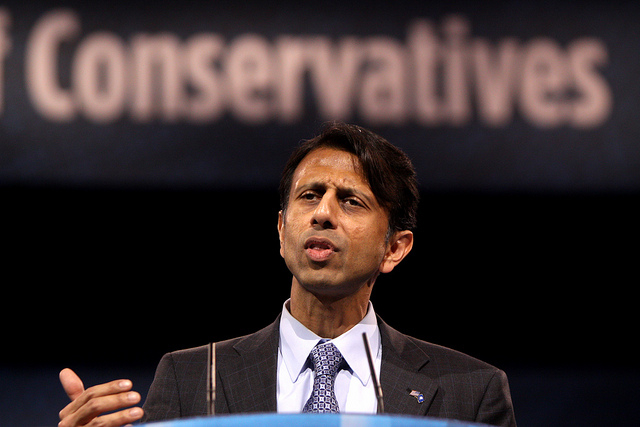It was September 2008. As George W. Bush prepared to leave office, something astonishing happened. Indian Prime Minister Manmohan Singh stated, “the people of India deeply love you, President Bush.” Though he had been treating US officials with uncharacteristic generosity since coming to office, for embattled Republicans, this gesture provided a brief victory for a president whose foreign policy was disastrous.
For many South Asians, however, Singh’s words were yet another example of a cynical political move by a well-heeled politician.
The tone of Singh’s comments was also not unfamiliar to American politicians. Rather, it was a performance that is equally observable in the Indian-American diaspora. America’s Indian community, which was found in the last census to be the country’s richest ethnic minority. The crowning achievements of its push for membership into the American upper class are high-ranking politicians in the Republican Party like Bobby Jindal (birth name: Piyush Jindal,) who was elected Governor of Louisiana in 2007.
Because Jindal is a political leader in the American south, questions of race obviously need to be addressed. Should Jindal’s success, and of those like him such as South Carolinian Governor Nicki Haley (birth name: Nimrata Nikki Randhawa), be taken as an indication that Indians are now considered “white”? And if so, how did that happen, and what are the consequences?
Historian David R. Roediger has written extensively on the social construction of whiteness in the United States. Roediger argues that whites are a unique ethnic grouping: this is because the idea of “whiteness” was synthesized in order to distance Americans from their slaves. Even before the Revolutionary War, the idea of being white in what would become the US was predicated on racial violence and slavery.
White communities had disproportionate access to wealth and power compared to non-white ones. Over time, privileged members of minority groups developed incentives to be identified as such. Thus, there is significant merit to the idea that we are witnessing the Indian-American diaspora’s version of this phenomena. Integration requires the ascendancy of a “white Indians,” in all the same ways it has required such of other minority groups.
Indeed, Indian-Americans have made notable efforts in this area. Take, for example, the landmark Supreme Court case, United States v. Bhagat Singh Thind, 261 U.S. 204 (1923.) Thind petitioned the court to accept his application for American citizenship due to his logic that, as an upper-caste Hindu in India, he belonged to the Aryan, Caucasian race. The Court shot him down, with Associate Justice George Sutherland writing that Thind was not Caucasian in the “common understanding” and that Indians like him could therefore not be a part of the “statutory category as white persons.”

Since the case, this standard definition of Caucasian has meant that being white in the United States has always been subject to fluidity and the selective assimilation of specific minority populations. Different minorities have become “white” at various periods of American history. Members of these minority groups have all followed a similar pattern of assimilation as America’s Irish or Italian populations. They also shared common characteristics with the Chinese immigrants who served on Mississippi’s infamous White Citizens’ Council and help enforce legislation of Jim Crow segregation (even as similar legislation discriminated against Asian-Americans, mainly of Japanese descent, in the western United States.)
It isn’t a very crooked road from serving on White Citizens’ Councils while being subject to immigration restrictions elsewhere, to Bobby Jindal becoming the Republican governor of Louisiana. All it requires is a bit of theater.
Legal scholar John Tehranian makes the argument that although racial pseudo-science was rejected, the common-knowledge standard for whiteness still drove institutional racism in the United States. Tehranian argues that in practice, this standard was performance-based: the ability of a population to be considered white depended on a number of factors, including their religious practices, education, and intermarrying. I would add that their willingness to dissociate from non-white ‘undesirables,’ was another important factor.
Through these attributes, Bobby Jindal has been able to ingratiate himself with influential whites in the GOP.
Religiously speaking, Jindal converted to Christianity. It could be argued that the articles Jindal wrote about his conversion while at Oxford University, and indeed the conversion itself, were a cynical attempt to dispel doubts about his background. However, this is highly subjective. Regardless of the conversion’s motivations, Jindal’s Catholicism helped smooth his inclusion.
The governor”s embrace of Catholicism is particularly interesting, given the history of anti-Catholic sentiment in the United States. However, with the integration of European immigrants into white communities, Catholicism has become acceptable enough that Jindal could use it to seem “whiter.” Of course, racial politics can be difficult to predict, as one of the many reasons that Jindal lost in his 2003 gubernatorial run is because his campaign refused to answer to Democrat attack ads about his Catholic, in addition to Indian, background.
In terms of education and intermarriage, the Louisiana governor boasts an extremely privileged education, having been schooled at Brown University, and the aforementioned Oxford. He was also named to a number of impressive academic societies, and had a successful business career. Jindal’s decision to marry college sweetheart Supriya Jolly instead of a white American could be overlooked, as a result, by Republican observers.
Culturally-speaking, Jindal, and the legion of “white Indians” who are like him, have never been in a more comfortable situation. The United States has come to embrace a variety of aspects of Indian culture. Much of this began in the 1960s, when India became a popular spiritual destination for Americans. Whether the Hare Krishnas or the Beatles, aspects of Indian religious culture became increasingly integrated into the American consciousness as an Eastern prescription for the ethical flatulence of modern American life.
With these narratives, and also with outward waves of immigration, came an additional storm of other cultural influences, such as cuisine and language. Expressing aspects of South Asian culture isn’t quite so unusual anymore in this country. These realities are better discussed elsewhere, though it is worth noting the important point that North Indian Punjabis have had a disproportionate effect on these exports due to their social and economic privilege.
Of course, the fact that Indian culture has become an accepted part of American life is less important for Jindal than the political narratives that he reinforces. Jindal is uniquely able to emphasize his immigrant roots in order to lend a desperately needed diversity plank to Republican policies.

Jindal’s hardline policies on immigration include the construction of a border fence, the increase of legal quotas, and that undocumented immigrants not only pay a fine, but also speak English, and “demonstrate a willingness to assimilate.” Jindal detailed these positions in a National Review op-ed which he purposefully began with the phrase “as a son of immigrants to this country[…].” His colleague Nicki Haley took this logic a step further, writing in her book Can’t Is Not An Option that she is “the proud daughter of legal immigrants– emphasis on the LEGAL. My parents played by the rules and waited their turn.” This speaks to a very real perspective in privileged areas of the South Asian diaspora, where our documented entry into the United States is cited as political capital against the undocumented.
And for Jindal and Haley, as well as white Indians like them, empty references to their own immigration status also become important political tools for the Republican Party. It allows Republicans to reliably defuse the important race issues at play in the immigration debate because Jindal’s and Haley are willing to discuss their minority status whenever it is needed to excuse anti-minority policies.
This is important because of how American racism has evolved to be much less explicit after the 1960s. Rather than publicly supporting segregation, Republican politicians made the discourse much more abstract. In the Southern Strategy crafted by strategists such as Lee Atwater, “segregation” became “states’ rights,” or “cutting taxes,” or other policy decisions that have disproportionately negative effects on black populations. This tack quarantines purely racial motivations for supporting many policy decisions, from the public sphere.
These strategies are most effective when a widespread consensus is manufactured that American racism ended with the Civil Rights Movement. This requires non-white figures who are willing to bolster the discourse, as it becomes much easier to deny that racism is still a major part of American politics when privileged minorities are willing to deny it as well.
In similarly abstract terms, Jindal allows himself to be readily cited as an exemplar for self-denying American racists. As the most educated and privileged minority, Indian-Americans have become touted as proof that the American Dream is still alive, and that other minorities are personally at fault for not achieving it. Haley articulated this viewpoint perfectly at the Republican National Convention last August, when she stated that “[her] parents loved that when they came to America, if you worked hard, the only things that could stop you were the limits you placed on yourself.”
White Indians (and other South Asians as well) have become an important part of American mythology of meritocracy, mainly because they are seen as the minority-that-could. This requires a popular erasure of their own significant privileges as affluent North Indian Punjabis, predominantly from the higher castes. It also erases important discussions of other parts of South Asian communities, such as lower-class Bengalis. All that matters is for the most successful to be advertised as the results of hard work in a country that purports to reward it.

And, inevitably, this lends massive weight to an ideology that is often used against the south’s African-American population, which is that the end of Jim Crow means that they ran out of ‘excuses’ to not actualize on the ample ‘opportunities’ available to them. When Haley says “limits you placed on yourself,” her words as a minority-that-could become implicitly defined against the minorities-that-can’t. As a result, South Asians enter the forefront of a new form of discourse that disparages Black Americans, and faults them personally for the nation’s structural failures.
It is deeply troubling that Jindal is also far to the right on policies that disproportionately affect Louisiana’s African-American community, such as restrictions on abortion, affirmative action, equal pay, and welfare. He is also extremely hardline regarding the war on drugs, is governor of a state that has the dubious honor of being prison capital of the world, and narrowly lost a fight last year to further privatize Louisiana’s prisons.
Ultimately, though, those who buy into this performance need to remember that despite the personal power it allows, there is no question about who is actually in control. The inclusion of other minorities under the umbrella of American whiteness is always under evaluation. While “whiteness” may no longer be openly debated in Supreme Court cases, it is unofficially debated and meditated upon by those Americans who are considered closer to ‘genuine whiteness.’
The performance never seems to be enough. There will always be new events on which whiteness must be once again proven, as Sikhs and Pakistani Muslims learned after 9/11. There will always be something suspicious or unusual that can be used as justification for exclusion. There will always be people who still do not accept your color credentials.
Ultimately, it is a new sort mythology, which begins to take control of people’s lives and demand ever-greater leaps of cynicism. Although what constitutes freedom is always debatable, it certainly does not include invisible ethnic restrictions that define integration.
Photographs courtesy of Gage Skidmore, Infrogmation, and Karen Apricot.Published under a Creative Commons license. Screenshot courtesy of the author.





